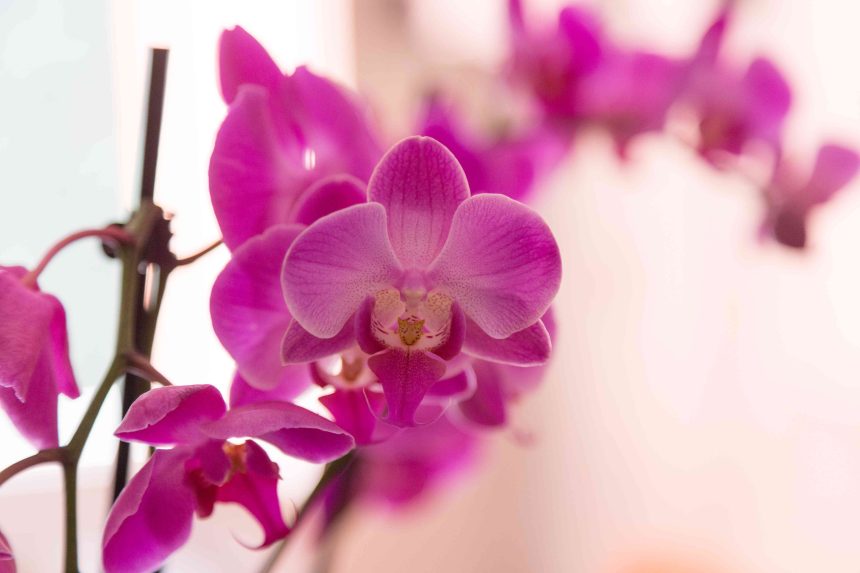Do orchids need sunlight? The simple answer is yes, but they can be picky about it. Different types of orchids need different types and amounts of light but almost all varieties respond poorly when exposed to too much bright, direct sunlight.
Most orchids grown as houseplants are native to tropical mountain and lowland rainforests. They are usually epiphytic which means they grow on trees or rocks with exposed root systems that take in nutrients from the air. Sunlight filters through the tree canopy to provide these unique plants with various levels of indirect light.
Growing orchids is a rewarding gardening project. Learn how to keep yours healthy and blooming year after year with the right kind and amount of light outlined in this guide.
How Much Light Do Orchids Need
A basic rule of thumb for orchid care is to provide bright, indirect light. Some types will tolerate direct exposure to morning sun, but midday and afternoon rays are too strong.
They can send your plant into energy overload, burn the leaves, and defeat the orchid’s ability to use nutrients efficiently. However, not enough sun throughout the day can result in failure to bloom.
Orchids may have low light or high light requirements or may fall somewhere in between. This refers to light intensity not the number of hours of exposure. The sun reaches its zenith around noon with rays that continue to increase in strength and heat for several hours. Daylight lasts longer during summer months which means sun exposure has higher intensity for more hours.
You don’t need to be a meteorologist to grow orchids but finding the best spot to place your orchid may require some trial and error. Here are light requirements for three common types of orchids to help you get started,
Phalaenopsis Orchids
Maryviolet / Getty Images
Phalaenopsis need six to eight hours of indirect sunlight during the growing season. Four to six hours is sufficient during winter months. Place these orchids near an east or south-facing window or filter direct light with a sheer curtain, blind, or shade. In southern climates, phalaenopsis may also thrive in a north-facing window.
If the undersides or leaf margins start to turn reddish-purple your phalaenopsis orchid is receiving too much direct light. Black or brown tips and spots on leaves are symptoms of sunburn. Signs of insufficient light include stunting, leggy growth, and long, droopy leaves.
Cattleya Orchids
Alvis Upitis / Getty Images
Cattleya are considered medium-light orchids and fail to bloom with inadequate exposure. They need a minimum of four hours of bright sunlight to flower. They tolerate direct sunlight in northern growing zones as long as they aren’t exposed to midday sun. Southern growers need to filter exposure for indirect light. Close to east and south-facing windows are the best locations for this orchid.
Red leaf margins indicate your cattleya orchid is getting too much direct sun. If leaves turn dark green light exposure is inadequate for blooming. Healthy cattleya leaves are light green.
Dendrobium Orchids
Orchi / Wikimedia Commons / CC BY-SA 3.0
Dendrobium orchids need six to eight hours of bright, indirect sunlight for good health and may need to be supplemented with grow lights, especially during winter months in northern growing zones. Place them in an east or south-facing window with a sheer or blind. Direct midday exposure can burn the leaves.
Dendrobium is a high-light orchid that fails to bloom with inadequate light. Weak stems are another sign of insufficient exposure. Black or brown spots on leaves and reddish-purple margins are signs of sunburn.
Want more gardening tips? Sign up for our free gardening newsletter for our best growing tips, troubleshooting hacks, and more!
Can You Grow Orchids in Low Light
Maryviolet / Getty Images
Phalaenopsis is considered a low-light orchid. Miltonia, ‘pansy’ and paphiopedilum, ‘lady slipper’ orchids are also considered low light types.
These orchids can’t use strong, high-energy rays of sunlight, which can even cause adverse affects, but they still need a certain number of hours of exposure to weaker morning rays.
They may be tolerant of afternoon shade but still require low-intensity morning light to thrive. Move these orchids to an east-facing window during winter months.
5 Signs Your Orchid Isn’t Getting Enough Light
- Leaves turn a darker green.
- Orchid fails to bloom.
- Leaves and stems are weak and floppy.
- Leaves are thin and elongated.
- Growth is slow or stunted.
FAQ
-
A good place to start is near an east facing window. Morning light is least likely to adversely affect most types of orchids. You can make adjustments if the orchid shows signs of too little or too much exposure.
-
Most orchids do not need direct sunlight although some with high light needs may tolerate direct morning sunlight. Amounts of bright, indirect light are better for most varieties.





